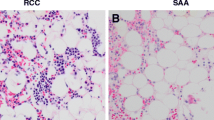Opinion statement
A new classification of myelodysplastic and myeloproliferative diseases in childhood has greatly facilitated the diagnosis of these uncommon disorders. Because hematopoietic stem cell transplantation (HSCT) can cure more than half of the affected children, palliative treatment strategies often applied in adult myelodysplastic syndrome (MDS) are of little importance in pediatric MDS. Unraveling some of the underlying genetic factors predisposing to MDS at a young age may give important insights into leukemogenesis in the elderly.
Similar content being viewed by others
References and Recommended Reading
Jaffe ES, Harris NL, Stein H, Vardiman JW: World Health Organization Classification of Tumours. Pathology and Genetics of Tumours of Haematopoetic and Lymphoid Tissues. Edited by Jaffe EJ, Harris NL, Stein H, Vardiman JW. Lyon: International Agency for Research on Cancer; 2001.
Kardos G, Baumann I, Passmore SJ, et al.: Refractory anemia in childhood: a retrospective analysis of 67 patients with particular reference to monosomy 7. Blood 2003, 102:1997–2003. This paper reviews clinical courses observed in a large cohort of children with refractory cytopenia.
Hasle H, Niemeyer CM, Chessells JM, et al.: A pediatric approach to the WHO classification of myelodysplastic and myeloproliferative diseases. Leukemia 2003, 17:277–282. This paper summarizes the present classification scheme employed in pediatric myelodysplastic syndrome.
Passmore SJ, Chessells JM, Kempski H, et al.: Paediatric myelodysplastic syndromes and juvenile myelomonocytic leukaemia in the UK: a population-based study of incidence and survival. Br J Haematol 2003, 121:758–767. This paper describes a large cohort of pediatric patients with myelodysplastic syndrome.
Hasle H, Baumann I, Bergstrasser E, et al.: The International Prognostic Scoring System (IPSS) for childhood myelodysplastic syndrome (MDS) and juvenile myelomonocytic leukemia (JMML). Leukemia 2004, 18:2008–2014.
Saunthararajah Y, Nakamura R, Nam JM, et al.: HLADR15 (DR2) is over-represented in myelodysplastic syndrome and aplastic anemia and predicts a response to immunosuppression in myelodysplastic syndrome. Blood 2002, 100:1570–1574.
Steensma DP, Dispenzieri A, Moore SB, et al.:Antithymocyte globulin has limited efficacy and substantial toxicity in unselected anemic patients with myelodysplastic syndrome. Blood 2003, 101:2156–2158.
Peters AMJ, Baumann I, Strahm B: Immunosuppressive therapy for children with refractory anemia [abstract]. Bone Marrow Transplant 2003, 31:S183.
Hicsonmez G, Tuncer AM, Sayli T, et al.: High-dose methylprednisolone, low-dose cytosine arabinoside, and mitoxantrone in children with myelodysplastic syndromes. Hematol Pathol 1995, 9:185–193.
Webb DK, Passmore SJ, Hann IM, et al.: Results of treatment of children with refractory anaemia with excess blasts (RAEB) and RAEB in transformation (RAEBt) in Great Britain 1990 to 1999. Br J Haematol 2002, 117:33–39.
Woods WG, Barnard DR, Alonzo TA, et al.: Prospective study of 90 children requiring treatment for juvenile myelomonocytic leukemia or myelodysplastic syndrome: a report from the Children’s Cancer Group. J Clin Oncol 2002, 20:434–440.
Sasaki H, Manabe A, Kojima S, et al.: Myelodysplastic syndrome in childhood: a retrospective study of 189 patients in Japan. Leukemia 2001, 15:1713–1720.
Hasle H, Kerndrup G, Yssing M, et al.: Intensive chemotherapy in childhood myelodysplastic syndrome. A comparison with results in acute myeloid leukemia. Leukemia 1996, 10:1269–1273.
Chan GC, Wang WC, Raimondi SC, et al.: Myelodysplastic syndrome in children: differentiation from acute myeloid leukemia with a low-blast count. Leukemia 1997, 11:206–211.
Niemeyer CM, Zecca M, Korthoff E, et al.: Allogeneic stem cell transplantation for children with advanced primary MDS: results from the EWOG-MDS study group employing a pretransplant preparative regimen with busulfan, cyclophosphamide, and melphalan [abstract]. Blood 2004, 104:632a.
Yusuf U, Frangoul HA, Gooley TA, et al.: Allogeneic bone marrow transplantation in children with myelodysplastic syndrome or juvenile myelomonocytic leukemia: the Seattle experience. Bone Marrow Transplant 2004, 33:805–814.
Leahey AM, Friedman DL, Bunin NJ: Bone marrow transplantation in pediatric patients with therapyrelated myelodysplasia and leukemia. Bone Marrow Transplant 1999, 23:21–25.
Deeg HJ, Storer B, Slattery JT, et al.: Conditioning with targeted busulfan and cyclophosphamide for hemopoietic stem cell transplantation from related and unrelated donors in patients with myelodysplastic syndrome. Blood 2002, 100:1201–1207.
Peters C, Matthes-Martin S, Fritsch G: Transplantation of highly purified peripheral blood CD34+ cells from HLA-mismatched parental donors in 14 children: evaluation of early monitoring of engraftment. Leukemia 1999, 13:2070–2078.
Locatelli F, Zecca M, Duffner U, et al.: Busulfan, cyclophosphamide, and melphalan as pretransplant conditioning regimen for children with myelodysplasia (MDS) and juvenile myelomonocytic leukaemia (JMML). Interim analysis of the EWOGMDS/ EBMT prospective study. Leukemia 2002, 14:971.
List AF, Vardiman J, Issa JP, Dewitte TM: Myelodysplastic syndromes. Hematology (Am Soc Hematol Educ Program) 2004, 297–317.
Barnard DR, Lange B, Alonzo TA, et al.: Acute myeloid leukemia and myelodysplastic syndrome in children treated for cancer: comparison with primary presentation. Blood 2002, 100:427–434.
Yakoub-Agha I, de La SP, Ribaud P, et al.: Allogeneic bone marrow transplantation for therapy-related myelodysplastic syndrome and acute myeloid leukemia: a long-term study of 70 patients-report of the French society of bone marrow transplantation. J Clin Oncol 2000, 18:963–971.
Hale GA, Heslop HE, Bowman LC, et al.: Bone marrow transplantation for therapy-induced acute myeloid leukemia in children with previous lymphoid malignancies. Bone Marrow Transplant 1999, 24:735–739.
de Witte T, Hermans J, Vossen J, et al.: Haematopoietic stem cell transplantation for patients with myelodysplastic syndromes and secondary acute myeloid leukaemias: a report on behalf of the Chronic Leukaemia Working Party of the European Group for Blood and Marrow Transplantation (EBMT). Br J Haematol 2000, 110:620–630.
Author information
Authors and Affiliations
Rights and permissions
About this article
Cite this article
Niemeyer, C.M., Kratz, C.P. & Hasle, H. Pediatric myelodysplastic syndromes. Curr. Treat. Options in Oncol. 6, 209–214 (2005). https://doi.org/10.1007/s11864-005-0004-3
Issue Date:
DOI: https://doi.org/10.1007/s11864-005-0004-3




